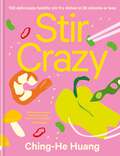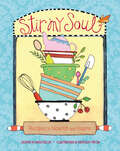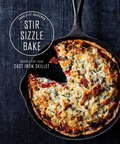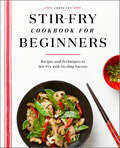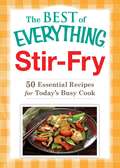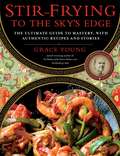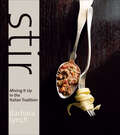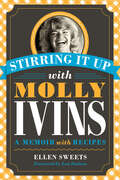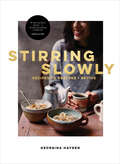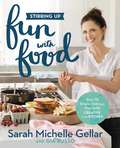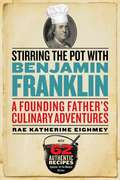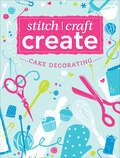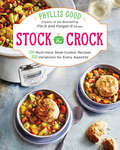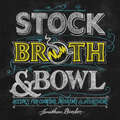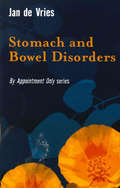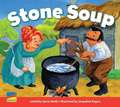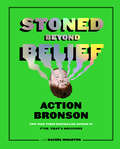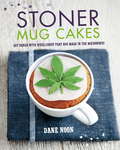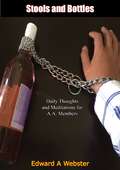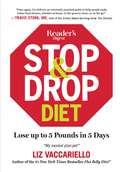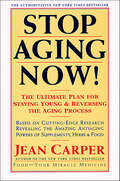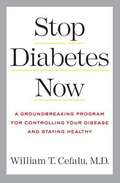- Table View
- List View
Stir Crazy: 100 Deliciously Healthy Stir-fry Recipes (Ching He Huang)
by Ching-He HuangWinner - Gourmand World Cookbook Awards: Best UK Chinese Cookbook 2017 Stir-frying is one of the quickest and easiest ways to cook - and one of the healthiest, using little oil and retaining more nutrients than many other methods. It also requires very little equipment - all you need a wok, a knife and a chopping board. Learning what separates a good stir-fry from a great one, however, is not always so easy to master. Indeed, it is all about timing, knowing when to add what and how to get the best out of each ingredient. With tips on everything from controlling the heat to using the right oil, bestselling author Ching-He Huang has gathered together a collection of delicious dishes, simple enough for every day and with nutrition, taste and affordability in mind. Many are gluten and dairy free, as well as suitable for vegans and vegetarians, and include both Asian and Western ingredients readily available in any supermarket. So whether or not you eat meat, love carbs or prefer to avoid them, want something special or find yourself having to feed your family, Stir Crazy will do the trick.
Stir My Soul: Recipes to Nourish and Inspire
by Roxie KelleyA beautifully illustrated collection of 100 easy-to-prepare recipes laced with thoughtful reflections on cooking and life.Have you ever noticed how the words that describe the cooking process also resonate in a more meaningful way to describe the very act of living? Stirring, blending, mixing, and measuring are terms that apply to how we live as well as how we cook. Bestselling cookbook author Roxie Kelley takes this correlation to heart and pairs her observations on life in and outside the kitchen with Kathleen Taylor’s distinctive bright, whimsical folk artwork inside Stir My Soul.From a Rustic Vegetable Breakfast Bake and Chunky Chicken Salad Sandwiches to Sweet and Sour Pork Chops, White Cheddar Potato Pancakes, and Roxie’s Favorite One Bowl Chocolate Chip Cookies, Stir My Soul presents more than 100 recipes alongside definitions of cooking terms and how those words translate to life experiences. As Roxie explains, “The words that describe actions required in cooking are the same ones that make up daily life: my family and friends are part of my “fold,” I “measure” my words when speaking to my children . . . all these life activities, like good recipes, lead to a satisfying result just like a completed dish or favorite dessert.” Consider Stir My Soul a coming to terms with terms, if you will—a collection of recipes certain to nourish your body and stir your soul.
Stir My Soul: Recipes to Nourish and Inspire
by Roxie KelleyA beautifully illustrated collection of 100 easy-to-prepare recipes laced with thoughtful reflections on cooking and life.Have you ever noticed how the words that describe the cooking process also resonate in a more meaningful way to describe the very act of living? Stirring, blending, mixing, and measuring are terms that apply to how we live as well as how we cook. Bestselling cookbook author Roxie Kelley takes this correlation to heart and pairs her observations on life in and outside the kitchen with Kathleen Taylor’s distinctive bright, whimsical folk artwork inside Stir My Soul.From a Rustic Vegetable Breakfast Bake and Chunky Chicken Salad Sandwiches to Sweet and Sour Pork Chops, White Cheddar Potato Pancakes, and Roxie’s Favorite One Bowl Chocolate Chip Cookies, Stir My Soul presents more than 100 recipes alongside definitions of cooking terms and how those words translate to life experiences. As Roxie explains, “The words that describe actions required in cooking are the same ones that make up daily life: my family and friends are part of my “fold,” I “measure” my words when speaking to my children . . . all these life activities, like good recipes, lead to a satisfying result just like a completed dish or favorite dessert.” Consider Stir My Soul a coming to terms with terms, if you will—a collection of recipes certain to nourish your body and stir your soul.
Stir, Sizzle, Bake: Recipes for Your Cast-Iron Skillet
by Charlotte DruckmanA new classic for the only pan you need A humble workhorse used for generations to crisp bacon perfectly and fry chicken, the cast-iron skillet can also turn out tender scones, cakes, and breads. A curious home cook, Charlotte Druckman has figured out every trick for this versatile pan. Heat the skillet for a few minutes, add some butter to sizzle, and you can brown cheesy arepas, get a crunchy crust on a kimchi-topped hoecake, or blister naan right on the stovetop. Or preheat the pan in the oven and you're ready to bake no-knead pizza, the gooiest sticky buns, and even a cornflake-milk layer cake. With beautiful photographs, tips for seasoning cast iron, and info on collecting vintage pieces, this book makes cooking so much fun that your skillet will never see the cupboard.
Stir-Fry Cookbook for Beginners: Recipes and Techniques to Stir-Fry with Sizzling Success
by Chris ToyEasy stir fry without a takeout box in sightQuick, naturally healthy, and full of richly varied flavors, stir fry is the perfect food. And the best part? Anyone can learn to make restaurant-quality stir fry at home! This complete guide makes stir frying simple with easy-to-follow directions that cover everything from prep work to serving. No matter your skill in the kitchen, you'll be enjoying the tantalizing spiciness of Kung Pao Chicken or a veggie-filled Buddha's Delight thanks to this standout among stir fry cookbooks.Go beyond other stir fry cookbooks with:Wok selections—Find out how to choose the right wok, season it, and properly maintain it for years to come.Stir fry step-by-step—Learn how to stir fry the right way, including preparing a variety of ingredients, keeping things moving in the wok, and finishing with sauces and garnishes.Cook up a full menu—Discover a robust range of sides and entrees featuring vegetables, meat, poultry, seafood, rice, and noodles.Create stir fry at home with ease with this top choice in stir fry cookbooks.
Stir-Fry: 50 Essential Recipes for Today's Busy Cook (The Best of Everything®)
by Adams MediaEverything® cookbooks are a popular choice for home cooks looking for fresh, original recipes that only taste like you’ve spent all day in the kitchen. But now we’ve collected fifty of our favorite stir-fry recipes to help you make easy, mouthwatering dishes. Here’s all you need to get started making tasty, satisfying recipes from Indian Curried Chicken to Gingered Pork with Udon Noodles.
Stir-Frying to the Sky's Edge: The Ultimate Guide to Mastery, with Authentic Recipes and Stories
by Grace YoungWinner of the 2011 James Beard Foundation Award for International Cooking, this is the authoritative guide to stir-frying: the cooking technique that makes less seem like more, extends small amounts of food to feed many, and makes ingredients their most tender and delicious.The stir-fry is all things: refined, improvisational, adaptable, and inventive. The technique and tradition of stir-frying, which is at once simple yet subtly complex, is as vital today as it has been for hundreds of years—and is the key to quick and tasty meals. In Stir-Frying to the Sky’s Edge, award-winning author Grace Young shares more than 100 classic stir-fry recipes that sizzle with heat and pop with flavor, from the great Cantonese stir-fry masters to the culinary customs of Sichuan, Hunan, Shanghai, Beijing, Fujian, Hong Kong, Macau, Taiwan, Singapore, and Malaysia, as well as other countries around the world. With more than eighty stunning full-color photographs, Young’s definitive work illustrates the innumerable, easy-to-learn possibilities the technique offers—dry stir-fries, moist stir-fries, clear stir-fries, velvet stir-fries—and weaves the insights of Chinese cooking philosophy into the preparation of beloved dishes as Kung Pao Chicken, Stir-Fried Beef and Broccoli, Chicken Lo Mein with Ginger Mushrooms, and Dry-Fried Sichuan Beans.
Stir: Mixing It Up in the Italian Tradition
by Barbara LynchA James Beard award–winning chef has “mastered her art, and the results are evident in this gorgeous, mouth-watering book” (Publishers Weekly, starred review).Although Barbara Lynch was born and raised in South Boston, not Tuscany, many critics believe her food rivals the best of Italy. It has been praised by Bon Appétit, Food & Wine, and Gourmet, and many more.Lynch’s cuisine is all the more remarkable because it is self-taught. She grew up in the turbulent projects of “Southie,” where petty crime was the only viable way to make a living. But in a home ec class in high school, she discovered her passion. Through a mix of hunger for knowledge, hard work, and raw smarts, she gradually created her own distinctive style of cooking, mining Italian and French classics for ideas and seasoning them with imagination.The 150 recipes in Stir combine sophistication with practicality. Appetizers like baked tomatoes and cheese and crisp, buttery brioche pizzas. Dozens of the artful pastas Lynch is famous for, such as little lasagnas with chicken meatballs, and potato gnocchi with peas and mushrooms. Lobster rolls with aïoli. Chicken wrapped in prosciutto and stuffed with melting Italian cheese. Creamy vanilla bread pudding with caramel sauce. Accompanied by Lynch’s forthright opinions and stunning four-color photographs, these dishes will create a stir on home tables.“Well worth the wait” —Tom Colicchio, James Beard Award winning chef, co-founder of The Gramercy Tavern and founder of Crafted Hospitality“Distinctive dishes, generous spirit, and a genuine cook are all bound up in this wonderful book.” —Michael Ruhlman, New York Times–bestselling author of Ratio
Stirring It Up with Molly Ivins: A Memoir with Recipes
by Ellen SweetsYou probably knew Molly Ivins as an unabashed civil libertarian who used her rapier wit and good ole Texas horse sense to excoriate political figures she deemed unworthy of our trust and respect. But did you also know that Molly was one helluva cook? And we’re not just talking chili and chicken-fried steak, either. Molly Ivins honed her culinary skills on visits to France—often returning with perfected techniques for saumon en papillote or delectable clafouti aux cerises. Friends who had the privilege of sharing Molly’s table got not only a heaping helping of her insights into the political shenanigans of the day, but also a mouth-watering meal, prepared from scratch with the finest ingredients and assembled with the same meticulous attention to detail that Molly devoted to skewering a political recalcitrant. In Stirring It Up with Molly Ivins, her longtime friend, fellow reporter, and frequent sous-chef Ellen Sweets takes us into the kitchen with Molly and introduces us to the private woman behind the public figure. She serves up her own and others’ favorite stories about Ivins as she recalls the fabulous meals they shared, complete with recipes for thirty-five of Molly’s signature dishes. These stories reveal a woman who was even more fascinating and complex than the “professional Texan” she enjoyed playing in public. Friends who ate with Molly knew a cultured woman who was a fluent French speaker, voracious reader, rugged outdoors aficionado, music lover, loyal and loving friend, and surrogate mom to many of her friends’ children, as well as to her super-spoiled poodle. They also came to revere the courageous woman who refused to let cancer stop her from doing what she wanted, when she wanted. This is the Molly you’ll be delighted to meet in Stirring It Up with Molly Ivins.
Stirring It Up with Molly Ivins: A Memoir with Recipes
by Ellen SweetsYou probably knew Molly Ivins as an unabashed civil libertarian who used her rapier wit and good ole Texas horse sense to excoriate political figures she deemed unworthy of our trust and respect. But did you also know that Molly was one helluva cook? And we’re not just talking chili and chicken-fried steak, either. Molly Ivins honed her culinary skills on visits to France—often returning with perfected techniques for saumon en papillote or delectable clafouti aux cerises. Friends who had the privilege of sharing Molly’s table got not only a heaping helping of her insights into the political shenanigans of the day, but also a mouth-watering meal, prepared from scratch with the finest ingredients and assembled with the same meticulous attention to detail that Molly devoted to skewering a political recalcitrant. In Stirring It Up with Molly Ivins, her longtime friend, fellow reporter, and frequent sous-chef Ellen Sweets takes us into the kitchen with Molly and introduces us to the private woman behind the public figure. She serves up her own and others’ favorite stories about Ivins as she recalls the fabulous meals they shared, complete with recipes for thirty-five of Molly’s signature dishes. These stories reveal a woman who was even more fascinating and complex than the “professional Texan” she enjoyed playing in public. Friends who ate with Molly knew a cultured woman who was a fluent French speaker, voracious reader, rugged outdoors aficionado, music lover, loyal and loving friend, and surrogate mom to many of her friends’ children, as well as to her super-spoiled poodle. They also came to revere the courageous woman who refused to let cancer stop her from doing what she wanted, when she wanted. This is the Molly you’ll be delighted to meet in Stirring It Up with Molly Ivins.
Stirring Slowly: From the Sunday Times Bestselling Author
by Georgina HaydenDiscover these feel-good recipes to restore, revive and rejuvenate, and enjoy the simple pleasures of food.Whatever your day looks like – there is a recipe here that is just right. Whether it is a quick and comforting noodle bowl or a hearty slow-cooked pie, this book celebrates food's power to restore, revive and rejuvenate. But it isn't just about the food on your plate: it's about how it gets there. Stirring Slowly celebrates time spent in the kitchen. Wile away a happy hour stirring a creamy black dhal, or give your undivided focus to flipping caramelised apple, ricotta and hazelnut pancakes – because cooking nourishes you inside and out.'The sort of book that has you immediately plastering its pages with post-it notes... the writing is warm, encouraging and moving' Nigella Lawson
Stirring Up Fun with Food: Over 115 Simple, Delicious Ways to Be Creative in the Kitchen
by Gia Russo Sarah Michelle GellarMore than 100 fun food-crafting ideas that will engage, delight, and amaze kids-from actress, entrepreneur, and mom, Sarah Michelle Gellar, and former Martha Stewart Living editor Gia Russo.Why stop with making basic brownies? Why not put them on a stick and decorate them? Why not take boring broccoli and turn it into a yummy cheese muffin instead? Sarah Michelle Gellar learned quickly that to get her kids to be adventurous with food, she had to involve them in preparing it. She wanted that process to be fun and help them develop self-confidence, creative thinking, and even math skills! So Sarah and co-author Gia Russo came up with more than 100 fun food-crafting ideas that take basic food preparation to a surprising new level.Organized by month, the book offers projects for every occasion and theme, including Super Bowl, Valentine's Day, Shark Week, Halloween, and even a Star Wars Day with licensed Star Wars creations! The possibilities are endless!
Stirring the Pot with Benjamin Franklin: A Founding Father's Culinary Adventures
by Rae Katherine EighmeyIn this remarkable work, Rae Katherine Eighmey presents Franklin's delight and experimentation with food throughout his life. At age sixteen, he began dabbling in vegetarianism. In his early twenties, citing the health benefits of water over alcohol, he convinced his printing-press colleagues to abandon their traditional breakfast of beer and bread for "water gruel," a kind of tasty porridge he enjoyed. Franklin is known for his scientific discoveries, including electricity and the lightning rod, and his curiosity and logical mind extended to the kitchen. He even conducted an electrical experiment to try to cook a turkey and installed a state-of-the-art oven for his beloved wife Deborah. Later in life, on his diplomatic missions--he lived fifteen years in England and nine in France--Franklin ate like a local. Eighmey discovers the meals served at his London home-away-from-home and analyzes his account books from Passy, France, for insights to his farm-to-fork diet there. Yet he also longed for American foods; Deborah, sent over favorites including cranberries, which amazed his London kitchen staff. He saw food as key to understanding the developing culture of the United States, penning essays presenting maize as the defining grain of America. Stirring the Pot with Benjamin Franklin conveys all of Franklin's culinary adventures, demonstrating that Franklin's love of food shaped not only his life but also the character of the young nation he helped build.
Stitch, Craft, Create: Cake Decorating
by VariousWant to try your hand at making gorgeous homemade goodies? These brilliant quick & easy cake decorating projects give you the opportunity to try something new and expand your crafting skills! From beautiful biscuits to floral cupcakes, festive treats to celebratory cakes designs, create stunning items for yourself, your friends and your home.Each unique project includes:Simple step-by-step instructionsQuick makes for fast resultsBeautiful photography of the finished product to guide and inspire
Stock the Crock: 100 Must-Have Slow-Cooker Recipes, 200 Variations for Every Appetite
by Phyllis GoodThe ultimate resource for a new generation of slow-cooker fans from the New York Times bestselling author who has sold 12 million cookbooks!Stock the Crock brings together the expertise of America's most popular slow-cooker authority with a fresh collection of 100 essential, innovative, and easy-to-prepare recipes-each with variations allowing readers to customize the dish according to their dietary needs. You'll find beloved classics, as well as dishes you might be surprised can be done successfully in a slow cooker. (Hello, slow-cooker creme brulee!) Whether you are looking to accommodate gluten-free, paleo, or vegetarian diets, or prefer slow-cooker meals perfectly sized for one or two people, this cookbook provides smart ideas, more than 100 recipe photos, and cooking hacks that will change the way you use your favorite fuss-free cooking appliance. Learn simple make-ahead tricks, convenient baking tips, and how to make two recipes at once using the same cooker, so you can simplify cooking and spend more time enjoying your family and friends around a wonderful, delicious meal.
Stock, Broth & Bowl: Recipes for Cooking, Drinking & Nourishing
by Jonathan BenderStock up on ways to make—and use—these versatile, flavorful building blocks of good nutrition.Whether you’re a seasoned cook or have never set foot in a butcher shop, Stock, Broth, and Bowl will help you dip your toe in the wildly popular bone broth pool. This book teaches you to prepare nine different stocks with straightforward recipes that are the foundation for great comfort food and the building blocks for creating nourishing drinking broths. You’ll learn about sourcing ingredients, having the right kitchen tools, and straining and storing stock.There are nine stock recipes in this book, including a recipe for bone broth and how to doctor it. You’ll recreate the essence of a multi-meat broth and discover the essential sweetness of root vegetables with a vegetarian broth. Stock, Broth, and Bowl also includes 20 recipes for turning stock into broth, into a delicious drink, or into dinner. The recipes range from one-pot meals like a savory bread pudding or decadent pot roast to broth-based cocktails. Get comfortable. Get simmering. Get well stocked!“A book for those who want to be exceptional cooks.” —John Currence, author of Pickles, Pigs, and Whiskey
Stomach and Bowel Disorders
by Jan de VriesThe stress and anxieties of modern life can take their toll on the digestive system. If not treated in their early stages, simple digestive and absorption disorders can develop into serious conditions such as ulcers, colitis or irritable bowel syndrome. Jan de Vries shares the results of 30 years' successful treatment of stomach and bowel problems, showing the reader how to interpret the body's warning signals and setting out simple and effective remedies, diets and exercises.
Stoned Beyond Belief
by Rachel Wharton Action BronsonThe ultimate love letter to the world’s most magical plant—weed—from the rapper, chef, TV star, and bestselling author of F*ck, That’s Delicious.This is an exploration of every corner of the pot galaxy, from highly scientific botanical analyses and the study of pot’s medicinal benefits to a guide to the wild world of weed paraphernalia. It’s also a very personal tribute to a substance Bronson refers to as life changing, horizon-expanding, a conduit for happiness, a connector. Weed is to Action Bronson what the madeleine was to Proust: the door to true consciousness. Organized loosely as 100 entries, including thirty-five recipes, and packed with illustrations and photos, Stoned Beyond Belief is a trippy and munchie-filled experience as well as an entertainingly valuable resource for weed enthusiasts and scholars. Stoned Beyond Belief will delight Action Bronson fans and pot aficionados all across the universe.
Stoner Mug Cakes
by Dane NoonMix your ingredients in a mug, then cook in your microwave for a delicious space cake. Even a stoner can do it and before you can say 'pass the spliff' your cake is cooked and ready to blow your mind.25 recipes for the least hassle when you want a delicious cake for getting baked. With a quirky design and full-colour photography throughout, give yourself the munchies (in every sense) with this ultimate guide to mug cakes for stoners.
Stoner Mug Cakes
by Dane NoonMix your ingredients in a mug, then cook in your microwave for a delicious space cake. Even a stoner can do it and before you can say 'pass the spliff' your cake is cooked and ready to blow your mind.25 recipes for the least hassle when you want a delicious cake for getting baked. With a quirky design and full-colour photography throughout, give yourself the munchies (in every sense) with this ultimate guide to mug cakes for stoners.
Stools and Bottles: Daily Thoughts and Meditations for A.A. Members
by Edward A WebsterFew programs in the world have enabled the hopelessly lost to regain their stability in the world more than Alcoholics Anonymous. This classic book, by the author of the “little Red Book”, offers daily meditations and insights into the plight of the alcoholic and the solution to the problems that they face.
Stop & Drop Diet
by Liz VaccarielloNew York Times best-selling author and Reader's Digest editor-in-chief Liz Vaccariello presents the easiest diet ever, offering quick and easy meals you can find or make anywhere you go using your favorite everyday brand-name foods--so you can drop up to a pound a day!Want to drop up to a pound a day? You don't have to give up your favorite foods or become a slave to your stove. Just follow this guide to lightening up by making little tweaks to your favorite breakfast, lunch, dinner, and snacks. After analyzing the more than 40,000 products in the average supermarket plus menu items at popular chain restaurants and ingredients in everyday recipes, New York Times best-selling author and Reader's Digest editor-in-chief Liz Vaccariello reveals the hidden fat bombs you're eating--and the simple, healthier substitutes that taste just as good. She tells you how to change brands, substitute similar foods, order better takeout and restaurant meals, and buy smarter at the grocery store. Losing weight has never been so simple! Featuring more than 500 photographs, Stop and Drop Diet offers a mix-and-match 3-phase meal plan that's designed for fast weight loss and maximum flexibility along with balanced nutrition for good health. In each phase, simply choose from the lists of quick and easy meals, which include a variety of: * packaged foods from the supermarket, from Kellogg's Special K granola bar to Starkist Chunk Light Tuna to Progresso canned soups and Lean Cuisine frozen dinners * restaurant and on-the-go choices, from Wendy's cheeseburger and McDonald's Egg McMuffin to Chipotle salads and TGIF's Sizzling Chicken and Spinach * simple 5-ingredient recipes, from a banana-berry smoothie to a turkey sandwich to a cheesy bean tortilla * snacks and desserts, from chips and salsa to ice cream sandwiches and even Starbucks cake pops There are no hard-to-find brands or expensive ingredients, and you can find something to eat anywhere you go, no matter what your taste or lifestyle. The book also includes: * an at-a-glance visual guide to the worst choices for each dish (the ones you want to stop eating) and the best choices for each dish (the ones you want to starting eating instead) * inspiring stories and advice from the 10 real readers who tested out the diet, most of whom lost more than a pound a day in the first 5 days and continued to lose weight steadily (up to 20 pounds in 4 weeks and counting!) * simple suggestions for substituting healthy, filling, and delicious foods to create your own meals to stop and drop a pound a day From the team that created the bestselling Digest Diet and 21-Day Tummy Diet, here is a healthy, effective, and sustainable way to lose weight fast and keep it off for life; Stop & Drop a Pound a Day is truly the easiest diet ever.
Stop Aging Now!: The Ultimate Plan for Staying Young & Reversing the Aging Process
by Jean CarperIn Stop Aging Now!, Jean Carper -- winner of the 1995 Excellence in Journalism Award from the American Aging Association (the nation's leading group of scientists investigating the biomedical aspects of aging), nationally syndicated columnist and leading authority on health and nutrition -- documents how antioxidant vitamins, minerals, herbs and food chemicals are the magic youth potions humans have been seeking for centuries. Based on exciting new scientific findings from leading institutions, Stop Aging Now! reveals the stunning truth: Much of what we call aging is not inevitable, but is needless and can be prevented and reversed to a startling degree by supplements and foods. Indeed, aging is often due to unsuspected deficiencies that can be readily corrected, and even people in their sixties, seventies and eighties can turn back the clock and recover their youth. Leading scientists have found that: Vitamins can prevent and reverse memory loss and other signs of aging. Vitamins and minerals can rejuvenate immune functions, restoring youthful resistance to infections and cancer. Antioxidants in foods and supplements can help prevent clogged arteries, heart attacks and general bodily deterioration. Many unfamiliar but readily available food chemicals can prolong life and preserve your vitality.
Stop Diabetes Now
by Lynn Sonberg William T. CefaluDiabetes does not have to control your life You are not alone. Millions of Americans have been diagnosed with diabetes and are facing its challenges. But you have the power to get your life back. You can not only prevent disabling complications, but also effectively stop the progression of the disease. Recent research proves the key is tight blood sugar control. Here, leading diabetes researcher Dr. William T. Cefalu distills the latest studies and offers a breakthrough program to halt your symptoms. Combining cutting-edge conventional and alternative therapies now available, Stop Diabetes Now arms you with the most up-to-date information, explaining: * How to control your glucose level painlessly and effectively * The incredible benefits of careful nutrition and simple exercise * How to manage your hunger * When medication makes sense * Which supplements have been proven to make a difference Stop Diabetes Now proves that diabetes doesn't have to be a grim sentence. Fight back and take charge of your health today with this simple step- by-step program.
